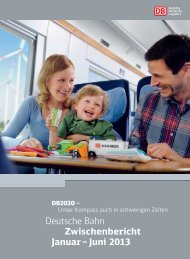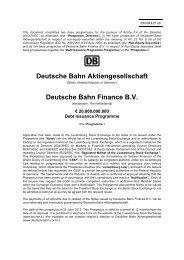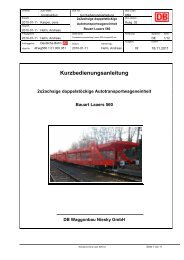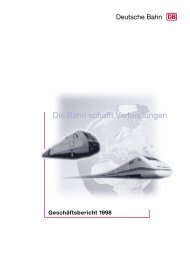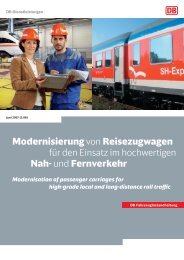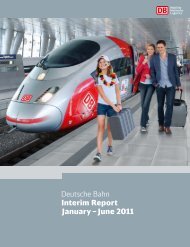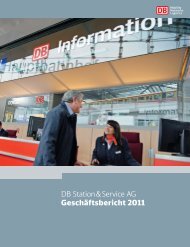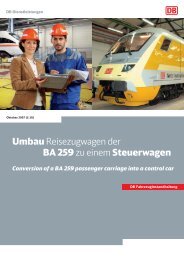You also want an ePaper? Increase the reach of your titles
YUMPU automatically turns print PDFs into web optimized ePapers that Google loves.
36<br />
<strong>Deutsche</strong> bahn group<br />
RESTRICTED AVAILABILITY OF ICE FLEET<br />
In October 2008, a routine ultrasound inspection of a series 411 /415 ICE T equipped with tilt technology<br />
found crack-relevant signs on two wheel sets. More information is available in the 2009 DB Group Annual<br />
Report on page 125. As a result, we made a commitment to the Federal Railways Agency to stop operating<br />
series 411 /415 ICE T vehicles with activated tilt technology and to conduct ultrasound inspections of the<br />
wheel sets at substantially shortened intervals of 20,000 km on the so-called line 87 (Stuttgart – Zurich)<br />
and 30,000 km on the remaining network. An immediately enforceable decision by the Federal Railways<br />
Agency dated March 16, 2010 requested further reductions of the intervals to 14,000 km for line 87<br />
and 21,000 km for the remaining network. An appeals proceeding against this decision is pending. The<br />
demands were, however, carried out as the authorities had ordered immediate implementation.<br />
The resulting limitations of the availability of the ICE fleet are leading to a shortage of sufficient<br />
reserve vehicles available for operation in the event of additional burdens. The number of reserve<br />
vehicles is principally conceived to ensure dependable service for the customer over the long term.<br />
The winter of 2009/2010 was marked by a long-lasting cold period that affected the entire nation<br />
with heavy levels of snowfall. Operations were burdened by increased damages, prolonged maintenance<br />
cycles, as well as operational delays. Due to the permanent pressures and restrictions facing the maintenance<br />
shops because of the additional ultrasound inspections of the wheel sets, severe weather conditions<br />
in early 2010 led to a substantial reduction in the availability of transport services.<br />
<strong>AG</strong>REEMENT REACHED WITH MANUFACTURERS<br />
ON REPLACEMENTS OF ICE T AXLES<br />
In October 2009 we reached a joint solution with Siemens and Bombardier for the replacement of ICE 3<br />
drive axles. By the end of February 2010 we also reached an agreement with Alstom for a joint solution<br />
to exchanging all wheel sets of the ICE T trains. The first step will be that the manufacturers will be<br />
responsible for developing and testing new drive axles for the ICE 3 as well as wheel sets and drive axles<br />
for the ICE T. The wheel set axles will then have to be approved by the Federal Railways Agency. Following<br />
approval, we will jointly agree with the manufacturers on implementing the exchange of axles and on<br />
the corresponding time plan. A total of about 1,200 drive axles of the ICE 3 are affected, and about 2,100<br />
of the ICE T.<br />
TIGHTENED REQUIREMENTS FOR FREIGHT CAR WHEEL SET AXLES<br />
Following an accident that took place in Viareggio /Italy in June 2009, when a train of Trenitalia Cargo<br />
carrying hazardous materials derailed, most likely because of a broken wheel set, the maintenance of<br />
freight car wheel set axles has come into sharper focus of railways and authorities. The European Railway<br />
Agency (ERA) has appointed a task force to determine mandatory rules regarding the maintenance<br />
of freight car wheel sets for the entire European sector of the rail freight system. The Federal Railways<br />
Agency has issued a general order mandating the ability to backtrack wheel sets for installation date,<br />
modification and last maintenance. Other national regulatory authorities, e.g. the Italian ANSF, have<br />
issued ordinances that influence the production process. Within the framework of its activities the<br />
task force has defined mea sures across Europe to the effect that the wheel set load of UIC wheel sets<br />
type A must be reduced from 21 to 20 tons, and the coarseness of the wheel set surfaces must be improved.<br />
At this time it cannot be ruled out that more far-reaching measures may become necessary because<br />
the ERA task force, in particular, is continuing its investigations via the joint support group.



